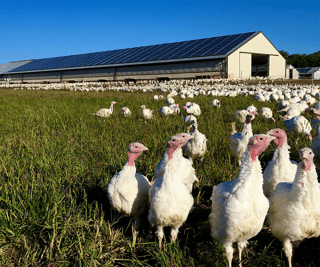
Drew Bowman’s free-range turkeys don’t use much electricity.
Rising electricity prices have been among the biggest factors driving up turkey farmers’ costs in recent years. Bowman, co-owner of Bowman & Landes Turkeys in New Carlisle, Ohio, is thankful for solar power.
Three solar arrays, including a 220-kilowatt system paid for in part with a $59,000 grant from the federal Rural Energy Assistance Program, or REAP, provide roughly half the farm’s electricity. That saves Bowman & Landes about $25,000 per year in energy costs.
“It’s been a nice addition to our company and our farm,” Bowman said.
The turkey farm and six other projects are spotlighted in a new report on REAP by the nonprofit Environmental Law & Policy Center, which is advocating for reforms as Congress considers its reauthorization in the latest Farm Bill.
Sign up for Energy News Weekly
Get the most important energy news of the week delivered directly to your inbox.
REAP provides grants or a combination of guaranteed loans and grants. More than 22,000 projects have received funding under the 20-year-old program so far. Under the 2018 Farm Bill, grants can pay up to 25% of an eligible project’s costs. The 2022 Inflation Reduction Act allows funding up to 50%.
“What we are recommending is that Congress harmonize those two pieces of legislation to simplify it for everybody” at the higher grant rate, said Andy Olsen, an Environmental Law & Policy Center policy advocate, at a Feb. 23 panel for USDA’s Agricultural Outlook Forum.
The Inflation Reduction Act also doubled the maximum grant amount to $500,000 for efficiency projects and $1 million for renewable energy systems, according to Deborah Yocum, a loan and grant analyst for rural development projects with USDA.
We want your feedback!
The Energy News Network wants to hear your thoughts so we can improve our coverage and newsletters. Help us out by taking this short survey.
Mandatory funding for REAP under the 2018 Farm Bill is $50 million per year. The program has generally enjoyed bipartisan support, although Farm Bill reauthorization frequently faces hurdles because it encompasses billions in political spending that dictate federal policy on food, nutritional support for families, biofuels, land use and more.
The 2022 Inflation Reduction Act provides additional funding of roughly $2 billion for REAP projects focused on clean energy, including technical assistance.
REAP’s clean energy focus “is really critical because of the role that climate change has in creating significant negative impacts on rural communities — agriculture as well as rural businesses,” said Karama Neal, administrator of USDA’s Rural Business-Cooperative Service.
Among other things, shifts in seasons can affect growing patterns and habits of pollinators, Olsen said. Heat waves, flooding and droughts also are problems in different places. “We are seeing that a lot of players in the marketplace want a low-carbon footprint in the products they sell,” he added.
“We’re about being environmentally responsible, so trying to have a green footprint,” Bowman said, but economics also played a big role in the decision to install solar arrays and apply for REAP funding.
“We’d love to keep the farm going,” Bowman said. His great-grandfather purchased the property in 1915, and an aunt still lives there. Bowman & Landes Turkeys was officially founded in 1948, and members of both his and the Landes families continue to work for the business 75 years later.
Solar panels “save us long term on energy bills,” Bowman said. Net metering also lets the business sell excess energy back to the grid. The panels installed in 2020 are rated for roughly twice the output of those first installed in 2011, he added. “It’s becoming more cost-effective.”
Overcoming barriers
As helpful as the REAP program has been, barriers to participation remain. Many farmers and small businesses can find the application process daunting. That’s especially true when it comes to technical information on cost estimates, projected energy savings, financial criteria and more.
Smaller farms may not have enough resources to navigate the process. And farms owned by Black Americans and other people of color often operate at those smaller scales.
“Most underrepresented farmers don’t have the supportive resources to apply for large-scale grants or even small- or mid-size grants,” said Ariella Brown, who previously worked with the Agraria Center for Regenerative Farming and chaired Ohio conferences on Black farming from 2020 to 2022.
At the Feb. 23 panel, Neal stressed USDA’s commitment to the Biden administration’s Justice40 Initiative, which states that 40% of overall economic benefits from government programs should flow to disadvantaged communities.
“Outreach is definitely key,” Yocum said. Comments from stakeholders will also help the agency make changes to the REAP program, including decisions about who will be eligible for the highest 50% funding level allowed under the Inflation Reduction Act.
“We are advocating that that be a sliding scale that reflects the goals of the program,” Olsen said. In his view, factors should include whether applicants are members of historically disadvantaged groups or underserved communities, as well as climate change risks and climate change mitigation.
More generally, a USDA energy coordinator in every state serves as a “front line” for questions, help with applications and so forth, Yocum said.
Talks are also underway to streamline the application process, Olsen said. One idea is a simplified rebate program for pre-approved technologies, including “no-brainer” energy efficiency projects, such as LED lighting or weatherization. “The whole idea here is to broaden the program.”
A faster turnaround in getting grant money out could help, too. REAP awards generally require people to pay upfront or get bridge loans, Olsen said.
The Environmental Law & Policy Center also wants zero-carbon projects for electrification to get priority. And a program like EPA’s Energy Star should inform buyers about the energy demands and costs for agricultural equipment, Olsen said. “We need to drive manufacturing forward and drive the technology forward.”
“In the future we’ll certainly look into further solar projects to try to become less energy-dependent on the grid and more on our solar panels,” Bowman said.



